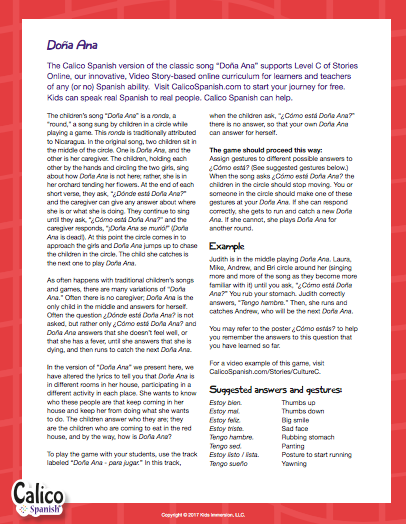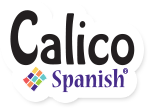NEW Spanish music for time, house, feelings, activities: Meet Doña Ana!
What do you get when you update a 100-year-old Spanish children’s ronda with a peppy country beat and lyrics related to time, the house, feelings, and activities? We can’t wait to show you.
 I know we’ve been releasing a lot of new music lately (see Pañuelito, and Amiguito, and Así me gusta a mí, and Todo mi cuerpo, and wait – there are still more!). But I confess this is the one I’m most excited about. I’ve been making up songs in Spanish to narrate our home life since my first child was born eight years ago, but this time, I had the chance to see it all the way through: find the right tune, adapt the lyrics just so, find the right musical talent, team up with the right animation talent: and wow, the finished product is one of my absolute favorite projects I’ve ever collaborated on.
I know we’ve been releasing a lot of new music lately (see Pañuelito, and Amiguito, and Así me gusta a mí, and Todo mi cuerpo, and wait – there are still more!). But I confess this is the one I’m most excited about. I’ve been making up songs in Spanish to narrate our home life since my first child was born eight years ago, but this time, I had the chance to see it all the way through: find the right tune, adapt the lyrics just so, find the right musical talent, team up with the right animation talent: and wow, the finished product is one of my absolute favorite projects I’ve ever collaborated on.
– Follow us on Twitter –
Doña Ana: Activities, house, time, and more
What’s so great about this song? For one thing, I feel like I found just the right tune basis for the lyrics. “Doña Ana” is a traditional children’s ronda, a song meant to be part of a game in which children dance in a circle and play in some way. You know them: “Ring around the Rosy.” “The Farmer in the Dell.” And “Doña Ana.”
– Like Calico Spanish on Facebook –
In our “Doña Ana,” you’ll find we’ve targeted these language functions in a fun, comprehensible, no-English way:
- telling time on the hour
- using gerunds related to activities in the house
- talking about rooms in the house
- using nosotros forms
- using puedo
- adding variety to the answers to the question ¿Cómo estás?
Introduce a child you love to a lifelong journey of speaking real Spanish to real people. Click the red button to experience it FREE.
And where did this come from?
Like any old, traditional children’s song, the lyrics change from place to place, as does the story of where it comes from, or even how you play it. In one version, Doña Ana is in the middle with her nurse, who keeps reporting how Ana is doing, until she’s dead, or pretending to be dead. Or something like that.
To get some more background on this fun children’s ronda:
- watch some Nicaraguan children play it,
- listen to this classic version (performed by the Munchkins, I think)
- check it out minus the nurse and plus some much older “children” and
- watch these adorable Venezuelan schoolchildren perform their version.
– Follow us on Instagram too! –
And where’s the video?
But I’ve got to say, I think ours is best. We’re indebted to the incredible musical talent of Obed Gaytán, yet again. Take a look, and tell us what you think. (And see below for the game version and instructions!)
And you say it’s a game?
Ready to get your early learners up and moving in a game of “Doña Ana”? Here’s the version made just for that purpose, without the answer to “¿Cómo está Doña Ana?” and here is a PDF of the instructions on how to play, including how to use the game to review any structure really, but it’s particularly great for using a variety of answers to “¿Cómo estás?”
We developed the song “Doña Ana no está aquí” to support Level C of Calico Spanish Stories. Level C is called “I Live Here” and includes learning targets involving telling time and talking about the house and activities in it, so you can see why we made the song! You can explore Level C and all of Stories for a full week, absolutely free; check it out here.
LYRICS
Doña Ana no está aquí,
en su cocina está,
limpiándola toda para ir a jugar
Vamos a visitarla, que son las cinco ya
a ver su casa roja, comer y hablar
¿Quién es esa gente
que pasa por aquí
de día y de noche
y no puedo salir?
Somos los niños
que venimos a comer
en la casa roja
Lo vamos a hacer
¿Cómo está Doña Ana?
“Tengo hambre.”
Doña Ana no está aquí,
en su sala está,
jugando su juego, y quiere ganar
Vamos a visitarla, que son las siete ya
a ver su casa roja, comer y hablar
¿Quién es esa gente
que pasa por acá
de día y de noche
y no puedo jugar?
Somos los niños
que venimos a comer
en la casa roja
Lo vamos a hacer
¿Cómo está Doña Ana?
“Estoy feliz.”
Doña Ana no está aquí,
en su baño está
bañándose toda para ir a dormir
Vamos a visitarla, que son las ocho ya
a ver su casa roja, comer y hablar
¿Quién es esa gente
que pasa por aquí
de día y de noche
ni me puedo vestir?
Somos los niños
que venimos a comer
en la casa roja
Lo vamos a hacer
¿Cómo está Doña Ana?
“Tengo sueño.”
Doña Ana no está aquí,
en su cuarto está
leyendo un libro para dormirse ya
Vamos a visitarla, que son las nueve ya
a ver su casa roja, comer y hablar
¿Quién es esa gente
que pasa por aquí
de día y de noche
y no puedo dormir?
Somos los niños
que venimos a comer
en la casa roja
Lo vamos a hacer
¿Cómo está Doña Ana?







2 Comments
¿Cómo puedo obtnener los acordes de estas canciones?
No tenemos una hoja de acordes disponible para la canción Doña Ana. Sin embargo, ofrecemos hojas de acordes para gran parte de nuestra otra música en Teachers Pay Teachers. ¡Esperamos que encuentres algo útil allí!